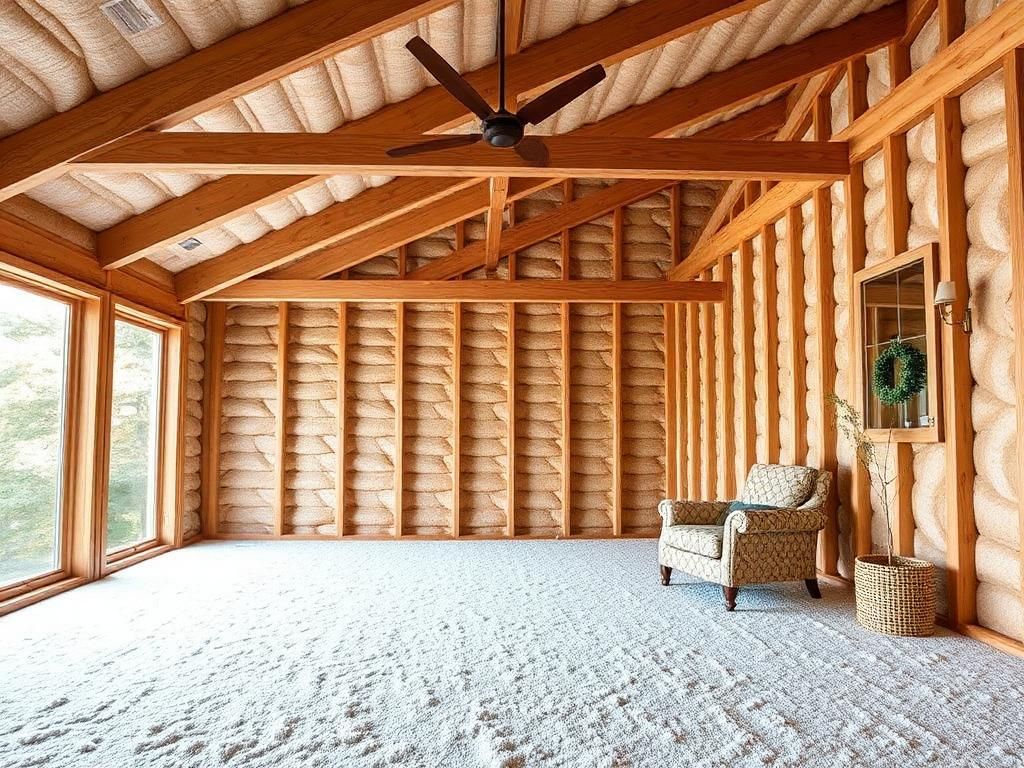Foam insulation plays a crucial role in modern construction and energy efficiency. It refers to various types of insulative materials that significantly enhance a building’s thermal performance. As energy costs rise and environmental concerns grow, incorporating foam insulation into your home or commercial structure becomes increasingly relevant. Not only does it help maintain comfortable indoor temperatures year-round, but it also offers noise reduction, moisture resistance, and overall improvement in energy efficiency.
Importance and Benefits
Energy Efficiency and Reduction of Energy Costs
One of the most compelling reasons to utilize foam insulation is its ability to greatly enhance energy efficiency. By minimizing air leaks and improving temperature maintenance, foam insulation significantly reduces heating and cooling costs over time. Homeowners can expect substantial savings on energy bills.
Soundproofing Qualities
Another vital benefit of foam insulation is its soundproofing capabilities. It consists of a dense structure, which effectively dampens noise transmission. Whether it’s from external traffic or internal activities, using foam insulation can result in a quieter living or working environment.
Moisture Resistance and Prevention of Mold Growth
There’s also the aspect of moisture resistance. Many foam insulation varieties, particularly closed-cell foam, act as a vapor barrier. This plays a significant role in preventing mold growth by keeping moisture at bay, thus contributing to healthier indoor air quality.
Versatility in Application Across Different Building Types
The versatility of foam insulation deserves a mention as well. It can be effectively used in a variety of settings, including residential homes, commercial buildings, and even industrial facilities. Whether you’re retrofitting an older structure or constructing a new one, foam insulation can be tailored to meet specific insulation needs.
Types of Foam Insulation
Spray Foam Insulation
Spray foam insulation is primarily categorized into two types: open-cell and closed-cell.
Open-Cell vs. Closed-Cell Foam
- Open-Cell Foam: This type is soft and flexible, making it ideal for filling irregular spaces. Although it offers excellent soundproofing and thermal performance, it has a lower R-value compared to closed-cell foam.
- Closed-Cell Foam: With a denser structure, closed-cell foam provides superior insulation and is also highly resistant to moisture. It has a higher R-value per inch, making it a great choice for areas prone to water exposure.
Applications and Use Cases
Spray foam insulation is applicable in various scenarios:
- Attics: It seals airflow and temperature leaks.
- Crawl Spaces: Effective in moisture control.
- Walls: Enhances energy efficiency in both commercial and residential buildings, making it a versatile choice.
Rigid Foam Board Insulation
Types of Rigid Foam Boards
Rigid foam insulation is another efficient option. There are three primary types:
- Polystyrene (EPS, XPS): Extruded Polystyrene (XPS) has water-resistant properties, while Expanded Polystyrene (EPS) is lightweight and economical.
- Polyurethane: Known for its superior insulation capabilities, polyurethane is often used in extreme environments.
Installation Techniques
Installation requires precision:
- Cutting and Fitting: Boards should be cut to size for a snug fit.
- Sealing Joints: Ensure airtight barriers by sealing joints with tape or foam sealant.
Foam Insulation Products
There are various foam insulation products on the market, including:
- Pre-Cut Foam Boards: Ideal for DIY projects.
- Spray Foam Kits: Convenient for small areas or touch-ups.
- Insulating Foam Sealants: Useful for filling gaps and cracks.
Comparing Brands and Their Offerings
When choosing products, consider factors such as R-value, ease of installation, and brand reputation. It’s essential to compare offerings to find the right fit for your insulation needs.
Installation Process of Foam Insulation
Preparation Steps
A successful installation begins with careful preparation.
Assessing Insulation Needs
To begin, conduct a home energy audit to pinpoint areas requiring insulation. This will help identify the most effective approach for implementing foam insulation in your space.
Materials Required
Gather the necessary tools and equipment for installation, including:
- Spray foam equipment
- Rigid foam board cutting tools
- Safety gear such as gloves and goggles
Step-by-Step Installation Guide
Spray Foam Insulation Installation
- Surface Preparation: Clean surfaces thoroughly to ensure adhesion.
- Applying the Foam: Use the spray equipment to apply foam evenly.
- Expansion and Curing Process: Allow adequate time for the foam to expand and cure completely.
Rigid Foam Board Installation
- Measuring and Cutting Boards: Measure spaces accurately and cut boards appropriately.
- Fitting and Securing Boards in Place: Fit boards snugly into the desired area and secure them.
- Sealing Edges: Use tape or foam to seal edges effectively for maximum insulation.
Advantages of Foam Insulation
Energy Efficiency and Cost Savings
Investing in foam insulation is not only about immediate benefits but also long-term savings. Once installed, it can lead to notable reductions in energy consumption, translating to lower utility bills. Homeowners can anticipate a swift return on investment.
Environmental Benefits
Moreover, using foam insulation contributes to sustainable building practices, lowering the carbon footprint of your home. Energy-efficient structures require less energy for heating and cooling, positively impacting environmental conservation efforts.
Comfort and Health Benefits
Foam insulation improves indoor air quality by minimizing drafts and preventing moisture buildup, thus creating a comfortable living environment. This promotes better health and wellbeing for occupants, providing a holistic benefit to insulation.
Common Concerns and Misconceptions
Safety of Foam Insulation
As with any material, concerns about safety are valid.
Flammability and Fire Safety
Many people worry about the fire safety of foam insulation. However, several foam products are moldable under fire ratings, meaning they will not ignite easily and can withstand higher temperatures. Always check for certification marks.
Chemical Exposure Risks
It’s essential to practice safe handling and installation methods to mitigate any risks associated with chemical exposure. Always use the recommended protective gear when working with insulation materials, particularly sprays.
Cost Considerations
Investing in foam insulation requires an upfront cost but evaluating long-term savings is vital.
Initial Investment vs. Long-Term Savings
The initial investment varies based on the type of foam insulation and installation complexity. However, several studies indicate that foam insulation can lead to a reduction in energy costs, often offsetting the initial expenses within a few years.
Market Comparison
Pricing for foam insulation may vary significantly depending on region, availability, and brand. It’s crucial to shop around and analyze your local market before committing to a product.
Maintenance and Longevity of Foam Insulation
Regular Checks and Maintenance Tips
Foam insulation requires minimal maintenance, but regular inspections can prolong its life.
Inspecting for Damage
Look for signs of wear or improper installation, which could affect efficiency. Cracks or exposure can expose materials that may lead to failures over time.

Weatherproofing and Integrity Over Time
To maintain integrity, regularly ensure that foam insulation remains watertight and shielded from pests that could cause damage over time.
Recommendations for Upgrades
Knowing when to upgrade insulation is crucial for optimal performance.
When to Consider Re-insulating
Homeowners should evaluate their insulation status occasionally, especially if energy costs begin to rise unexpectedly or if homeowners notice drafts during winter.
Combining Insulation Types for Maximum Efficiency
For the best results, consider integrating foam insulation with other insulation types (such as fiberglass) to maximize energy efficiency across different areas of the home.
| Benefit | Description |
|---|---|
| Energy Efficiency | Reduces heating and cooling costs, saving money long-term. |
| Soundproofing | Minimizes noise transmission, enhancing indoor quiet. |
| Moisture Resistance | Prevents mold growth, promoting better indoor air quality. |
| Versatility | Applicable in numerous residential and commercial settings. |
| Environmental Impact | Supports sustainable construction practices and reduces carbon footprint. |
| Health Benefits | Contributes to improved indoor comfort and health. |
Frequently Asked Questions (FAQs)
1. What is foam insulation, and how does it work?
Foam insulation provides effective thermal resistance by minimizing air leakage and creating a barrier to heat transfer.
2. How is spray foam insulation applied?
Spray foam is applied using a specialized spray equipment, filling gaps and cracks upon application.
3. Can foam insulation help reduce noise pollution?
Yes, foam insulation is effective in soundproofing, thanks to its dense structure that absorbs sound waves.
4. Is foam insulation safe for my home?
When installed correctly and using fire-rated products, foam insulation is safe for residential applications.
5. What areas of my home can I insulate with foam?
Foam insulation can be applied in attics, crawl spaces, walls, and more, making it a versatile option.
6. How often should I check my foam insulation?
Regular inspections should be conducted annually to check for damage or loss of insulating effectiveness.
7. Does foam insulation require maintenance?
Foam insulation requires minimal maintenance, but periodic checks can prolong its life.
8. Can I install foam insulation myself?
While DIY is possible, hiring a professional is recommended for optimal safety and effectiveness.
9. How does foam insulation contribute to energy savings?
Foam insulation enhances thermal performance, lowering energy costs from heating and cooling systems.
10. What are the cost considerations when using foam insulation?
Though initial costs may be higher, the long-term savings on energy bills typically make foam insulation a worthwhile investment.


